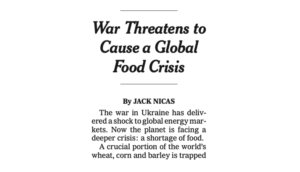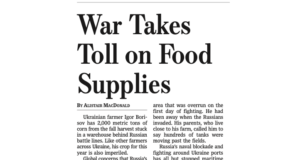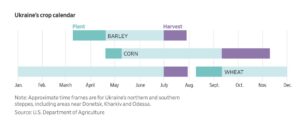The USDA is projecting that the ag trade deficit will shrink in FY2026 even more than previously anticipated. USDA expects the trade deficit to fall from $43.7 billion in FY2025…
“Global Food Crisis” Possible- – “No Precedent Even Close to This Since World War II”
Writing on the front page of today’s New York Times, Jack Nicas reported that, “The war in Ukraine has delivered a shock to global energy markets. Now the planet is facing a deeper crisis: a shortage of food.

“A crucial portion of the world’s wheat, corn and barley is trapped in Russia and Ukraine because of the war, while an even larger portion of the world’s fertilizers is stuck in Russia and Belarus. The result is that global food and fertilizer prices are soaring. Since the invasion last month, wheat prices have increased by 21 percent, barley by 33 percent and some fertilizers by 40 percent.
“The upheaval is compounded by major challenges that were already increasing prices and squeezing supplies, including the pandemic, shipping constraints, high energy costs and recent droughts, floods and fires.”
Nicas stated that,
Now economists, aid organizations and government officials are warning of the repercussions: an increase in world hunger.
Today’s article noted that, “‘Ukraine has only compounded a catastrophe on top of a catastrophe,’ said David M. Beasley, the executive director of the World Food Program, the United Nations agency that feeds 125 million people a day. ‘There is no precedent even close to this since World War II.’
“Ukrainian farms are about to miss critical planting and harvesting seasons. European fertilizer plants are significantly cutting production because of high energy prices. Farmers from Brazil to Texas are cutting back on fertilizer, threatening the size of the next harvests.”
The Times article indicated that, “‘A lot of people think that this is just going to mean that their bagels are going to become more expensive. And that’s absolutely true, but that’s not what this is about,’ said Ben Isaacson, a longtime agriculture analyst with Scotiabank. Since the 1970s, North Africa and the Middle East have grappled with repeated uprisings. ‘What actually led to people going into the streets and protesting?‘ he said. ‘It starts from food shortages and from food price inflation.'”
Meanwhile, Alistair MacDonald reported in today’s Wall Street Journal that, “Ukrainian farmer Igor Borisov has 2,000 metric tons of corn from the fall harvest stuck in a warehouse behind Russian battle lines. Like other farmers across Ukraine, his crop for this year is also imperiled.
“Global concerns that Russia’s invasion would curtail Ukraine’s 2022 harvest have come to fruition. The crop shortfall will extend to the many countries that rely on Ukraine for wheat, corn and cooking oil.
“With wheat already in the ground, and only a few weeks left to plant corn, farmers in Ukraine can’t get needed fertilizers and chemicals. They are low on fuel for tractors and other farm equipment. Workers are quitting to join the fight or to leave the country, leaving farms short-handed.”

Today’s article stated that, “Mr. Borisov said he and other farmers need to start their corn, sunflower and barley crops in April and May. That is now in doubt, and the impact on food supplies and prices will be felt world-wide.
“‘We hope we will plant, and we want to plant, but the situation is totally unpredictable,’ Mr. Borisov said. ‘You cannot build a forecast on Vladimir Putin. ‘

“Ukraine’s nutrient-rich soils yield 10% of global wheat exports, 14% of corn exports and about half of the world’s sunflower oil, according to the U.S. Department of Agriculture.
In just three weeks, war disrupted Ukraine agriculture, triggering higher prices as well as the threat of global shortages.
“Much of the exports go to developing economies already struggling with food-cost inflation.”
MacDonald added that, “Russia’s naval blockade and fighting around Ukraine ports has all but stopped maritime shipping and left limited means for transporting goods. Wheat prices have hit record levels over the effect on Ukrainian and Russian shipments.
“Like Ukraine’s military efforts, the country’s agriculture sector is rallying. Exports are being rerouted, and Ukraine is asking the U.S., Poland, France and others for supplies, said Taras Vysotskyi, Ukraine’s deputy minister of agrarian policy and food. In the best case scenario, the country’s agricultural exports will fall by a fifth this year compared with 2021, he said, but a much bigger drop is more likely.
“Should Russian forces leave immediately, Dmitry Skorniakov said, his four farms would still struggle to resume work. Tractors, chemical sprayers and a grain silo were destroyed on one farm located close to the besieged city of Mariupol, he said. Some of his workers have left to join the country’s defense.”
Also today, Reuters News reported that, “The war between Ukraine and Russia, two of the world’s top crop producers, could lead to a food crisis ‘on the global’ scale, French farming minister Julien Denormandie said in Brussels on Monday ahead of a EU agriculture meeting.”
And Financial Times writer Andy Bounds reported yesterday that, “The EU is reviewing the bloc’s sustainable food strategy after a concerted push against the planned reforms by national governments, farmers and the agriculture industry.
“Brussels agreed two years ago to reform its farm practices as part of a drive to eliminate net carbon emissions by 2050. But Russia’s invasion of Ukraine has seen a drop in grain and fertiliser exports from those countries and raised concerns over food security.
“The bloc’s agriculture ministers meet on Monday to discuss both short-term measures to alleviate the risk of shortages and price rises and possible changes to its Farm to Fork sustainable food strategy.”





